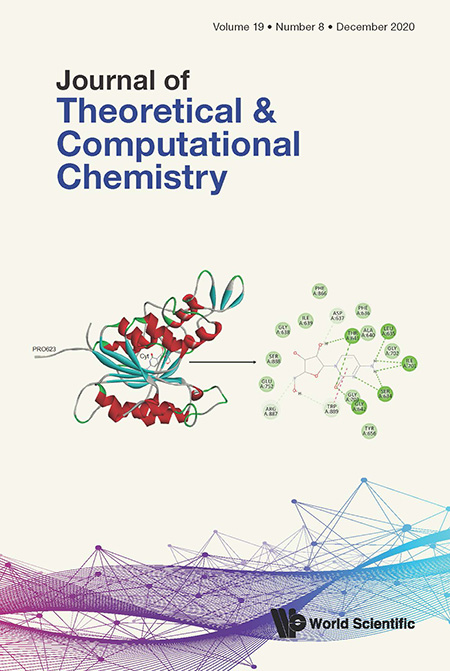Volume 19, Issue 08 (December 2020)
RESEARCH PAPERS
No Access
In vitro Acetylcholinesterase inhibitory activity of polyphenolic compounds identified from Matricaria recutita
2050029
https://doi.org/10.1142/S0219633620500297

- A series of thirteen PC compounds were extracted from Matricaria recutita (MR) flower.
- Molecular docking was performed to insight the potential inhibitory activity of PC against Acetylcholinesterase (AChE).
- The results showed that Kaempferol-3-O-rutinoside (KR) and Luteolin-8-C-glucoside (orientin) (LG) are the most significant inhibitory extracted compounds against AChE. It can be concluded that MR is a significant source to inhibit AChE.
RESEARCH PAPERS
No Access
Electronic transport induced by doping on the electrodes in molecular devices
- Jingjuan Yang,
- Jinlei Wei,
- Bin Liao,
- Baoan Bian,
- Guoliang Wang,
- Xu Zhang,
- Xianying Wu,
- Jun Luo, and
- Lin Chen
2050030
https://doi.org/10.1142/S0219633620500303

- Molecular device with doping nitrogen atoms on the left electrode is proposed.
- Effect of nitrogen atom doping on the left electrode on switching and rectifying behavior are discussed.
- Oscillating current effect with the increase of bias is observed.
RESEARCH PAPERS
No Access
Exploration of adsorption behavior, electronic nature and NLO response of hydrogen adsorbed Alkali metals (Li, Na and K) encapsulated Al12N12 nanocages
- Riaz Hussain,
- Muhammad Imran,
- Muhammad Yasir Mehboob,
- Muhammad Ali,
- Riaz Hussain,
- Muhammad Usman Khan,
- Khurshid Ayub,
- Mirza Arfan Yawer,
- Muhammad Saleem, and
- Ahmad Irfan
2050031
https://doi.org/10.1142/S0219633620500315

- NLO response along with electronic properties of metal encapsulated Al12N12 nanocages were explored followed by hydrogen adsorbed metal encapsulated Al12N12 nanocages.
- Results of these parameters recommend metal encapsulated nanocages as efficient contributor for possible applications in hydrogen sensors materials and in optoelectronic materials.
RESEARCH PAPERS
No Access
Radical scavenging activity of hydroxycinnamic acids in polar and nonpolar solvents: A computational investigation
2050032
https://doi.org/10.1142/S0219633620500327

- The radical scavenging activity of a series of hydroxycinnamic acids (HCAs) is studied in polar and non-polar solvents at the SMD//M05-2X/6-31+G(d,p) level of theory.
- The mechanism and the radical scavenging potency of HCAs are influenced by solvent polarity and our calculations are in agreement with experimental measurements performed in ethanol.
- The ortho substitution of caffeic acid by strong electron donating groups leads to a notable increase of its radical scavenging activity and new potent HCA derivatives are designed.
RESEARCH PAPERS
No Access
Halogenated derivatives of cytidine: Structural analysis and binding affinity
2050033
https://doi.org/10.1142/S0219633620500339

- Halogenated derivatives of cytidine were investigated.
- Binding affinity of derivatives against DNA methyltransferase were investigated.
- The obtained in silico results indicated helpful information of ligand…target interactions.
RESEARCH PAPERS
No Access
Designing of near-infrared sensitive asymmetric small molecular donors for high-efficiency organic solar cells
- Muhammad Yasir Mehboob,
- Muhammad Usman Khan,
- Riaz Hussain,
- Rafia Fatima,
- Zobia Irshad, and
- Muhammad Adnan
2050034
https://doi.org/10.1142/S0219633620500340

- Herein, four D-A-Á backbone based SMDs are designed and studied with aid of advances quantum chemical techniques.
- All calculations have been performed at MPW1PW91/6-31G(d,p) basis set.
- The computed results of all analysis suggest that our designed SMDs have better photovoltaic, opto-electronic and photo-physical properties as compared to R molecule.
RESEARCH PAPERS
No Access
Comparative study on the oily exudation of aluminized explosives containing EVA and F2603
- Jun Tao,
- Xiaofeng Wang, and
- Kun Zhang
2050035
https://doi.org/10.1142/S0219633620500352

- Comparative study on the oily exudation of aluminized explosives containing EVA and F2603 was carried out. The binding energies of wax with the components of RDX-based aluminized explosives containing EVA and F2603 were predicted. Then the migration models of wax in EVA and F2603 were constructed, respectively. Further, the migration rate of wax in two binders was calculated, and the experimental verification was also carried out. The results show that the type of binders has a great influence on the migration rate of wax, and the oily exudation rate of wax in F2603 is about 4 times than that in EVA both at 298K and 344K. Meanwhile, the polymer configuration greatly changes the migration rate of wax. The calculated results agree well with the experimental results.
ERRATUM
Free Access
ERRATUM: Combining enhanced sampling with experiment-directed simulation of the GYG peptide
2092002

